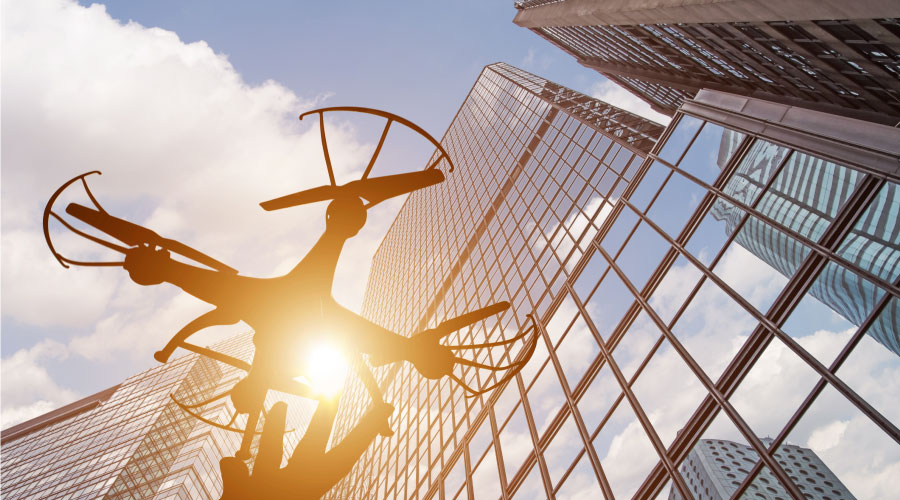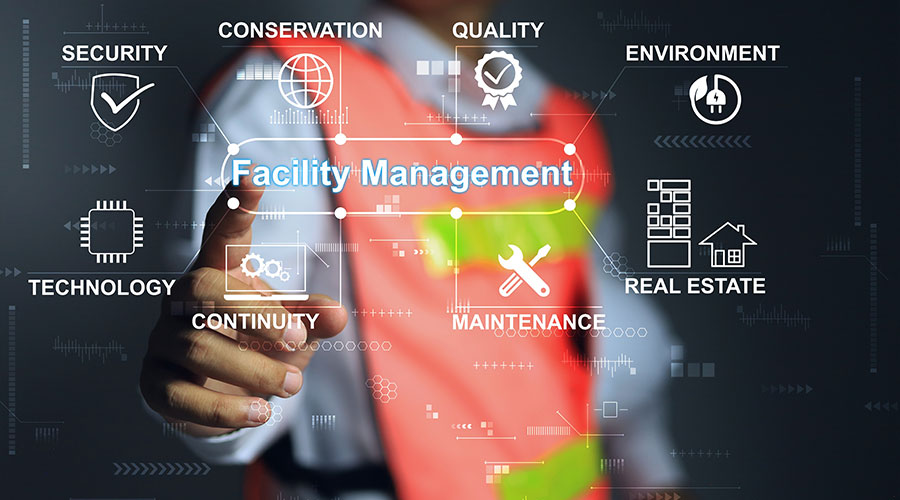What's the Buzz on Drones for Facility Management?
Here’s everything you need to know about starting an uncrewed aerial system (UAE) or drone program at your organization.
By Michael Gips , Contributing Writer
Once a novelty, uncrewed aerial systems (UASs) have become a valuable commercial tool for delivery of goods, aerial mapping, photography, and large-event oversight. In the past decade, UASs—or, more colloquially, drones—find themselves to be a promising tool in facilities management.
The drone market is expected to increase logarithmically. According to a forecast by Grand View Research, the global market for commercial UASs stood at almost $30B in 2022. It is expected to grow at a 38.6 percent compound annual growth rate to 2030, reaching almost $600B.
In short, drones are taking the world by swarm.
How do facility managers establish a drone program? What are the business advantages? And what do facility managers need to know about the legal and regulatory environment? Let’s investigate.
Starting a UAS Program
Relatively few companies have mature drone programs. Often, there is no existing budget for an in-house drone program and little on-site expertise.
Businesses frequently start with Drones-as-a-Service providers. Specialty companies offer turnkey solutions: drones, software, pilots, trainers, maintenance services, and so on. One global shipping company has opted for this approach as it experiments with drones for applications including short-distance delivery, vehicle counts, staffing checks, and incident response. Key to the decision to use a drone service was that the provider assumed all operational risk.
The downside of this model is that contractors gain access to your facilities, logistics, operations, processes, and personnel. This can expose sensitive or proprietary information to outsiders.
Organizations interested in developing a UAS program internally should research the various types of drones and drone software. Fixed-wing, rotor-based, and tethered drones each have their advantages and disadvantages in terms of flight time, power supply, range, speed, payload capacity, and other factors. For example, a company looking for an aerial overview of operations might choose a tethered drone, because it has a ground-based power supply, can hover for hours, and is a cost-effective alternative to building a pole or other tall structure and affixing a camera.
Potential UAS purchasers should be aware that Chinese firms account for about 85 percent of drone sales in the United States—because they have the lowest price tags. However, an expose published by the Washington Post and security firm IPVM in February 2023 pointed out that the biggest manufacturer is subsidized by the Chinese government. The problem, which multiple state and federal agencies including DHS have emphasized, is that sensitive data on U.S. infrastructure captured by Chinese drones is flowing into Beijing. The current commissioner of the Federal Communications Commission recently warned Chinese drones pose “a serious national security threat due to the level of sensitive information [they collect] and the potential for Beijing to access that data.”
That’s why several states have banned its public agencies from using Chinese drones. Legislation before Congress proposes to do the same at the federal level. While these laws don’t apply to private entities, the same concerns apply to business.
Benefits of Drones
UASs bring many advantages to companies—safety, rapid response, facility oversight, security, process management-- via attached cameras and other payloads including lights, claws, environmental sensors, and LiDAR. Engineering and extractive services companies routinely use drones for inspection of pipelines for cracks or leaks; some even fly mini-drones inside the pipes. During the Covid pandemic, the Atlanta Falcons used UASs to sanitize their stadium.
Electric companies use drones to check on the integrity of power lines, wind turbines, and other infrastructure. Drones inspect the blades on the turbines to assess whether they are operating correctly and are in good repair. In the past, staff would have to stop the turbine for the day, then manually inspect the blades. Keeping the turbine operating allows power generators to continue to generate profit from energy production while also getting real-time results to maintenance.
Drones also benefit facilities and infrastructure that are in the middle of nowhere. Energy companies operate power lines, substations, and turbines in unpopulated areas, where it is expensive to station dedicated personnel or respond to a problem. It could take hours for a staff person to get to the site of a mechanical issue. A drone stationed nearby can evaluate the impact before personnel are sent to the site.
Outdoor use of drones is regulated by the FAA, but indoor use is not. Businesses fly drones in warehouses, arenas, shopping malls, industrial plants, greenhouses, and other enclosed spaces to manage inventory, oversee processes, scan shipping labels, look for safety issues or medical emergencies, and check traffic and pedestrian flow. They can reach areas inaccessible or hazardous to humans, such as chemical storage areas or near ceilings. Of course, navigating indoor spaces presents greater challenges to pilots and operators.
UASs also offer security and safety benefits. They can detect encroachment of a facility’s perimeter; respond to and interdict an incident such as an active assailant; surveil a venue; assist in investigations; or even patrol a facility, augmenting or replacing security officers. At least one automotive company has used tethered drones to watch for other drones or corporate spies trying to access innovative features in new vehicles being tested on outdoor tracks.
The Legal and Regulatory Environment
Before starting a drone program, companies must be aware of legal and regulatory requirements. Federal, state, county, and municipal laws and regulations govern use of UASs. Licenses are issued by the Federal Aviation Administration (FAA), but flight operations are often regulated at a more local level.
A federal drone license, known as an FAA Part 107 license, has many restrictions. For example, the drone may not exceed 55 lbs, and it cannot fly over 400 feet high or more than 400 feet higher than a nearby structure. It may not be flown directly over people not participating in its operation, and it must remain in visual line of sight, among various other limitations. The FAA issues waivers to these rules, but the process takes time and effort.
UASs are becoming cheaper, lighter, smarter, and more agile. They are proving their worth via multiple cost-saving applications in facility management. As uptake continues, the buzz is only getting louder. It may be time to give drones a spin at your site or organization.
Michael Gips is a security professional, attorney, journalist, and principal at Global Insights in Professional Security. He has published more than 1,000 articles.
Related Topics:












